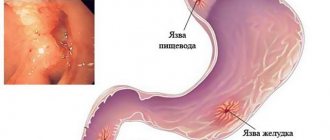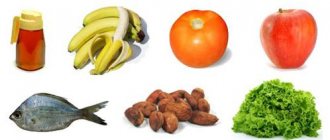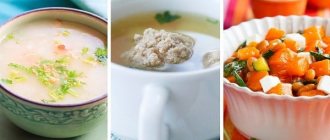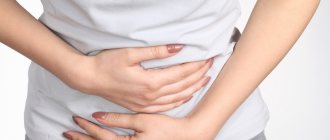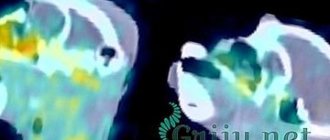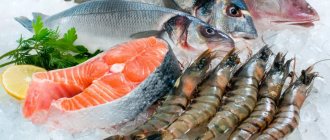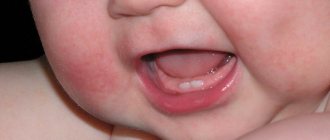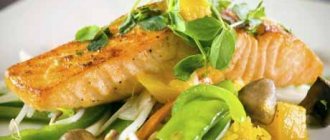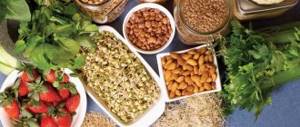Diet goals
A therapeutic diet helps reduce pain and helps the mucous membranes of the digestive tract recover faster. Proper nutrition during intestinal bleeding helps achieve the following goals:
- Reduce the load on the stomach and esophagus by eliminating mechanical, thermal and chemical irritants from the diet.
- Reduce the inflammatory process, promote wound healing.
- Ensure a balanced supply of all nutrients under strict bed rest.
- Reduce the active production of gastric juice.
- Improve intestinal motility.
- Accelerate the patient's recovery process.
Bleeding stomach ulcer
Bleeding gastric ulcer is one of the most common complications of gastric ulcer, which occurs in 10-15% of patients of all age groups and accounts for about 50% of all gastrointestinal bleeding. However, the statistics are inaccurate: a large percentage of cases are simply not recorded - minor blood loss is masked by symptoms of exacerbation of the underlying disease. Most often, this pathological condition develops with ulcers localized on the lesser curvature of the stomach. Gastric bleeding is an urgent problem in gastroenterology, since its prevalence is growing, and, despite the constant improvement of methods of endoscopic, drug hemostasis and early diagnosis, mortality remains high - about 9%.
General rules of nutrition after stomach bleeding
The diet for stomach bleeding requires strict adherence to the following rules:
- The menu should be completely balanced and contain the required amount of vitamins and minerals.
- Meals are small, frequent - from 4 to 6 times a day. Food should be taken in small portions at regular intervals.
- Daily calorie content should not exceed 2600 kcal.
- All food should be taken only warm, at a temperature no higher than 62°C and no lower than 15°C. The consistency of the dishes is liquid or semi-liquid.
- Preferred culinary processing is blanching vegetables, steaming, boiling, stewing. Fried, salty, spicy foods are completely prohibited.
- Salt should be limited to 5-8 grams per day.
- Maintain hydration – drink at least one and a half liters of liquid per day.
Dangerous signs of vomiting blood
General symptoms correspond to the usual manifestations of vomiting syndrome. With hematemesis, signs of a general impairment of health are immediately noted, manifested by a sharp loss of strength and weakness, and unpleasant aching pain in the gastric region.
The main indicator of upcoming hematemesis: increased salivation and intoxication, the manifestation of sharp and severe pain in the area of the digestive tract and stomach.
Bloody clots are not immediately noticeable; they are mixed with mucus, food debris and saliva. The presence of bloody inclusions can be felt by a specific metallic taste in the mouth. A mild burning symptom appears in the larynx and esophagus (a sign of irritation of the mucous membranes).
- The color of the vomit varies from pink to brown. It all depends on the freshness of the blood and the time of its coagulation.
Excessive hemorrhages and frequent bouts of vomiting can provoke chronic fatigue syndrome, thirst, arterial hypotension, cold sweat and signs of dizziness. During the genesis of nasal hemorrhages or toxic poisoning, loss of consciousness may occur. In severe cases - bloody streaks in the stool, fever and all signs of intestinal poisoning or indigestion.
It is the type and presence of such signs that can give the right direction in the diagnostic search for the main genesis of hemorrhage.
A large role in diagnosis is given to the examination of the patient and objective data during his examination, characterizing the level and duration of blood loss, the continuation or cessation of vomiting with blood.
1) With prolonged bleeding: patients are frightened, restless and agitated. They cannot find a comfortable position in bed, they are thirsty, there is frequent yawning and loss of consciousness, which indicates cerebral hypoxia, and with large blood loss - dry mouth.
- Coldness of the extremities, bluishness of the skin (acrocyanosis) and lips are noted. Breathing is shallow and frequent.
Table of permitted and prohibited products
Nutrition for bleeding stomach ulcers helps improve the patient's condition, mainly by limiting carbohydrates. All products that stimulate the secretion of gastric juice or irritate the mucous membrane of the stomach or intestines are completely excluded from the menu. The list of prohibited and permitted products includes:
| You can eat | Eating is prohibited | |
| First meal | Dairy, vegetable, cereal slimy soups. | Meat, fish, mushroom broths. |
| Boiled meat | Beef, veal, rabbit, chicken (without skin). Boiled eggs are allowed. | Pork, lamb, goose, duck. |
| Boiled or steamed fish | Low-fat varieties - cod, perch, pike. | Fatty varieties, salted fish. |
| Vegetables | Zucchini, potatoes, carrots, beets, pumpkin. | Vegetables rich in coarse fiber: cabbage, mushrooms, radishes, onions, cucumbers, sorrel, legumes, spinach, horseradish. |
| Cereals and porridges | Buckwheat, oatmeal, white rice, semolina. | Corn, pearl barley, millet, barley, brown rice. |
| Bakery products | Rusks, yesterday's bread made from whole grain flour. | Wheat bread |
| Dessert | Marshmallows, marshmallows, meringue, jam, jelly, sweet fruits. | Ice cream, candies, chocolate, pastries, dried fruits. |
| Sausages | Sausages, sausages, ham, smoked products. | |
| Beverages | Carrot, pumpkin juice, mineral water, tea, weak coffee with milk. | Alcohol, kvass, sweet soda. |
| Dairy | Milk, kefir, sour cream, cottage cheese, yogurt. | High fat cheese |
Causes of bleeding stomach ulcers
Most often, bleeding is complicated by chronic callous and acute gastric ulcers if the patient has pathology of the cardiovascular system, as well as ulcerative defects that develop during the use of glucocorticosteroids. The main reasons for the development of this complication are the progression of inflammatory and destructive processes in the defect area, increased capillary permeability, and blood clotting disorders. Usually, an arrosive artery bleeds, less often a vein or a large number of small vessels localized in the area of the bottom of the ulcer (in this case, hidden diapedetic bleeding develops). The formation of a bleeding ulcer can be facilitated by mechanical or chemical injuries to the mucous membrane, physical or psycho-emotional stress, neurotrophic and thromboembolic lesions of the stomach wall and hypovitaminosis.
The cause of the serious condition of patients is blood loss. With a loss of less than 15% of blood volume, there are no significant disturbances in systemic hemodynamics, since protective mechanisms are activated: spasm of blood vessels in the skin and abdominal organs, opening of arteriovenous shunts, and increased heart rate. Blood flow in vital organs is maintained, and when blood loss stops, the volume of circulating blood is restored due to natural depots. With a loss of more than 15% of the bcc, a generalized spasm of blood vessels, a significant increase in heart rate and the transition of interstitial fluid into the vascular bed are initially compensatory in nature, and then pathological. Systemic blood flow is disrupted, microcirculation suffers, including in the heart, brain, kidneys, arterial hypotension develops, and compensation mechanisms are depleted. Possible development of liver and kidney failure, cerebral edema, myocardial infarction and hypovolemic shock.
Menu
A diet after gastric bleeding is prescribed for a period of 3 to 6 months. Sometimes the timing may vary up or down, at the discretion of the doctor. The menu must be thought out in advance, taking into account the list of permitted and prohibited products. Approximate diet for 3 days:
| First day | Second day | The third day | |
| Breakfast | Omelette of two eggs with milk, 50 g of cottage cheese with fruit, tea. | Buckwheat porridge with milk – 100 g, tea with milk. | Steam omelette of 2 eggs, a cup of compote. |
| Lunch | Fruit salad – 150 g. | Apple baked with cottage cheese. | Milk. |
| Dinner | Glutinous rice soup (200 ml), 1 steamed fish cutlet, vegetable puree 100 grams. | Vegetable puree soup 200 ml, 80 grams of steamed chicken cutlets, blanched vegetables - 100 g. | Buckwheat soup-puree 200 ml, meatballs with carrot puree 150 grams. |
| Afternoon snack | A cup of cocoa with diet cookies. | Kissel, crackers. | Kissel, crackers. |
| Dinner | Mashed potatoes 150 g, 1 meatball, beetroot and carrot salad - 100 grams. | Fish baked with vegetables – 150 g, pasta – 100 g, rosehip decoction. | Mashed potatoes 150 g, fish 100 g, tea with milk. |
| Before bedtime | Baked apple. | A glass of milk. | Baked apple. |
Treatment methods
Treatment of gastric bleeding and bleeding from the duodenum, in the vast majority of cases, is carried out using conservative methods without surgical interventions.
In some situations, bleeding stops spontaneously. What happened does not mean that the help of a doctor will not be required. The chance of relapse is 100 percent. Properly prescribed complex treatment allows you to eliminate the disease and achieve stable remission.
No matter how the disease of the stomach and duodenum progresses, the patient must be hospitalized in a surgical hospital. If the patient has a large amount of blood loss, perforation, and a picture of hemorrhagic shock develops, hospitalization in the intensive care unit and resuscitation department is possible.
Strict bed rest is mandatory. The patient is strictly forbidden to move, drink water or eat food.
Initial stage of treatment
At the initial stage of inpatient treatment of the patient, emergency hemostatic therapy is performed. An intramuscular injection of vikasol is given, and calcium chloride or calcium gluconate is injected intravenously. A solution of aminocaproic acid is injected intravenously. The therapy is aimed at the formation of a blood clot in the damaged vessel and the elimination of bleeding.
If the bleeding is severe, the volume of blood loss is quite large, and the bleeding gastric ulcer is large, the patient may be transfused intravenously with red blood cells. The procedure allows you to normalize the volume of circulating blood. After volume restoration, the patient is subject to further monitoring for clinical signs of continuation or cessation of bleeding.
Further treatment
Further tactics for treating gastric ulcer bleeding directly depend on the location of the ulcer. If bleeding occurs from the lower esophagus, tamponade is performed using an inflatable balloon catheter inserted into the patient's mouth. The balloon is inflated with air, which compresses the damaged vessel, stopping the bleeding. It is possible to stop bleeding from the esophageal vessels using chemical sclerosis. A special fibrosing substance is introduced.
Duodenal ulcers are often treated conservatively. If the ulcer is perforated, the damaged area is sutured. A perforated duodenal ulcer is sutured in a transverse direction, preventing the development of cicatricial intestinal strictures.
Endoscopic treatment
Endoscopic therapy occupies a large place in modern operative surgery, sometimes replacing extensive surgical interventions. A similar category of diseases includes a stomach ulcer complicated by bleeding. Using special equipment, the lumen of the damaged vessel is cauterized using an electric current of a certain frequency. At the same time, a substance is injected into the vein, causing an increase in blood clotting.
If the above measures do not bring the expected results, the attending physician decides to perform surgery. A bleeding gastric ulcer is sutured or organ resection is performed. The extent of the operation depends on the location and area of the damage.
Endoscopy of a stomach ulcer

